Nerves Of The Upper Limb Questions And Answers
Question 1. Outline the nerve supply of the upper limb.
Answer:
- The brachial plexus (C5, C6, C7, C8, T1) provides nerve supply to the upper limb.
- The major nerves originating from the brachial plexus are:
- Axillary nerve
- Musculocutaneous nerve
- Radial nerve
- Median nerve
- Ulnar nerve
Nerves of Upper Limb Anatomy Notes PDF
Question 2. Write in detail about the brachial plexus and make notes on Erb’s and Klumpke’s paralysis.
Answer:
- The brachial plexus is the plexus of nerves formed by the anterior (ventral) rami of the last four cervical and first thoracic spinal nerves. (C5, C6, C7, C8, T1)
- It is divided into five subunits:
- Roots
- Trunks
- Division
- Cords
- Branches.
Read And Learn More: Upper Limb
Mnemonic: Brachial Plexus Subunits
- ‘Randy Travis Drinks Cold Beer’:
- Roots
- Trunks
- Divisions
- Cords
- Branches
- Roots
- They constitute the anterior primary rami of C5 to T1 spinal nerves.
- They are located in the neck.
- Trunks
- The upper trunk is formed by the union of C5 and C6 roots
- The middle trunk is formed by C7 alone
- The lower trunk is formed by the union of C8 and T1 roots
- They are also located in the neck.
- Divisions
- Each trunk is divided to form anterior and posterior divisions.
- They are located behind the clavicle
- Cords
- The lateral cord is formed by the union of the anterior division of the upper and middle trunks.
- The medial cord is a continuation of the anterior division of the lower trunk.
- The posterior cord is formed by the union of the posterior division of all trunks.
- Cords are located in the axilla.
- Branches of the Brachial Plexus
- From roots
- Long thoracic nerve/nerve to serratus anterior
- Dorsal scapular nerve/nerve to rhomboids
- From trunks
- Suprascapular nerve
- Nerve to the subclavius
- From cords
- From the lateral cord
- Lateral pectoral nerve
- Lateral root of the median nerve
- Musculocutaneous nerve
- From the medial cord
- Medial pectoral nerve
- Medial cutaneous nerve of the arm
- Medial cutaneous nerve of the forearm
- Medial root of the median nerve
- Ulnar nerve
- From the lateral cord
- From roots
- From the posterior cord
- Radial nerve
- Axillary nerve
- Thracodorsal nerve/nerve to latissimus dorsi
- Upper subscapular nerve
- Lower subscapular nerve
- From the posterior cord
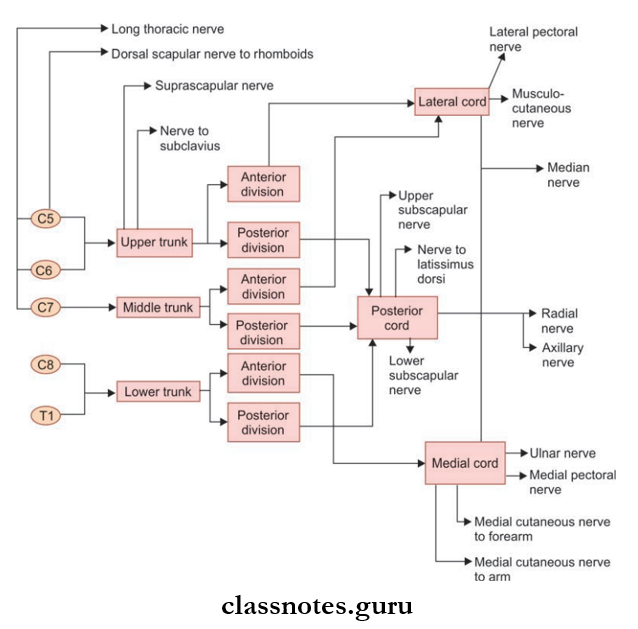
Mnemonic: Brachial plexus: Branches of the posterior cord
STAR
- Subscapular [upper and lower]
- Thoracodorsal
- Axillary
- Radial
Clinical Anatomy: Two types of lesions occurring in the brachial plexus are important.
- Erb’s paralysis:
- There is a point in the brachial plexus where six nerves meet called Erb’s point. These meeting nerves are:
- 5th and 6th cervical roots
- The upper trunk is formed by the union of these nerve roots
- Suprascapular nerve and nerve to subclavius, branching from the upper trunk
- Any accident which causes an increase in angle between the head and shoulder can cause injury to the upper brachial plexus most commonly at Erb’s point.
- It results in a specific type of paralysis of the upper limb known as Erb’s paralysis
- For example, A fall on the shoulder, birth injury, following anesthesia, etc.
- The clinical features are given in the table.
- There is a point in the brachial plexus where six nerves meet called Erb’s point. These meeting nerves are:
- Klumpke’s paralysis.
- It is another type of paralysis of the upper limb caused by accidents that increases angle between the trunk and shoulder making injury to lower brachial plexus.
- For example, Sudden upward pulling of the arm, birth injury, etc.
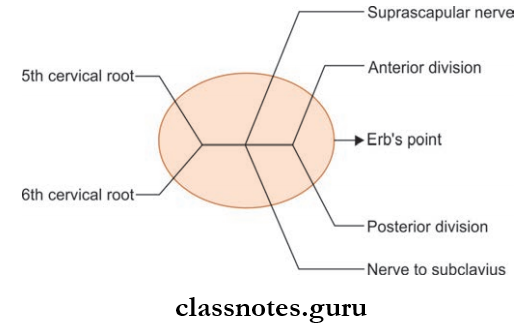
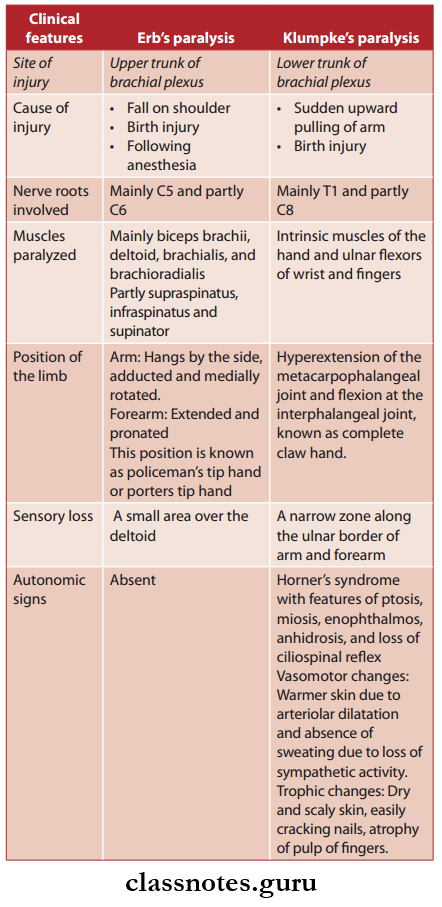
Upper Limb Nerve Injuries – Essay and MCQs
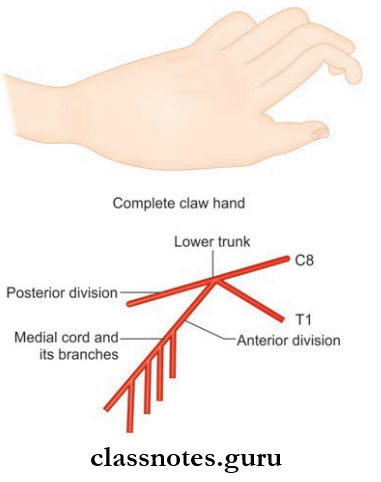
Question 3. Explain in detail about the axillary nerve under headings—origin, root value, course, branches, and innervation. Make a note on the injury to the nerve.
Answer:
- It is called axillary because it runs through the upper part of the axilla.
- It is called circumflex because it courses around the surgical neck of the humerus.
Axillary Nerve Origin
- It is a smaller terminal branch of the posterior cord of the brachial plexus.
Axillary Root Value
- Ventral rami of C5, C6 segments.
Axillary Nerve Course
- From the posterior cord, it passes backward through the quadrangular intermuscular space.
- After reaching back, it divides into anterior and posterior divisions below the capsule of the shoulder joint.
- The posterior division again divides and one part continues as upper lateral cutaneous nerve and the other part goes to supply deltoid and teres minor with a pseudoganglion in it.
- The anterior division supplies the deltoid muscle and skin over its anteroinferior part (regiment badge).
Brachial Plexus and Nerves – Medical Students Guide
Axillary Nerve Branches and Innervation
- Trunk Of Axillary Nerve
- Articular branch to the shoulder joint
- Anterior Division
- Muscular branch to the deltoid- cutaneous branch to the skin over deltoid’s anteroinferior part (regimen badge)
- Posterior Division
- The cutaneous branch continues as the upper cutaneous nerve of the arm.
- Muscular branch to the teres minor and posterior part of the deltoid.
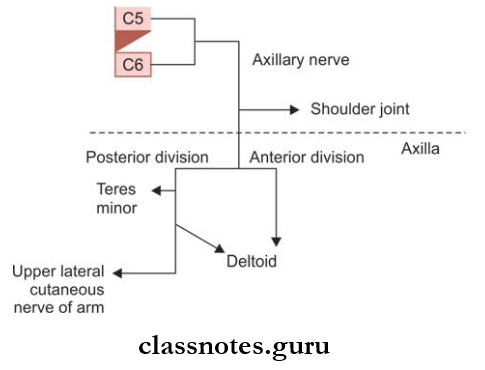
Axillary Nerve Clinical Anatomy
- The axillary nerve can easily get injured in inferior dislocation of the humerus or in injury to the surgical neck of the humerus.
- The presentation will be:
- Impaired abduction.
- Loss of contour of the shoulder due to deltoid muscle wasting.
- Loss of sensation over the lower half of the deltoid (regimen badge)
Nerves of Arm and Hand – Short Notes
Question 8. Write a note on the cutaneous supply of the upper limb.
Answer:

- The upper limb is supplied by C3–T2 spinal segments
- This is via:
- Supraclavicular nerves (C3 and C4)
- Nerves from brachial plexus (C5–T1)
- Intercostobrachial nerve (T2)
- Pectoral Region
- Above the 2nd rib by supraclavicular nerves (C3, C4)
- Below the 2nd rib by intercostal nerves (T2–T6).
- Axilla
- Intercostobrachial nerve (T2)
- Small branches from (T3).
- Shoulder
- Upper half of deltoid by supraclavicular nerves (C3, C4)
- The lower half of the deltoid by the upper lateral cutaneous nerve of the arm.
- Arm
- Upper medial part by the intercostobrachial nerve (T2)
- Lower medial part by the medial cutaneous nerve of the arm (T1, T2)
- Upper lateral half by upper lateral cutaneous nerve of arm
- Lower lateral part by lower lateral cutaneous nerve of arm (C5, C6)
- Posterior aspect of the arm by the posterior cutaneous nerve of the arm (C5).
- Forearm
- The medial side of the forearm by the medial cutaneous nerve of the forearm (C8, T1)
- The lateral side of the forearm by lateral cutaneous nerve of the forearm (C5, C6)
- Posterior aspect of the forearm by the posterior cutaneous nerve of the forearm (C6, C7, C8).
- Hand
- Palmar Surface
- Lateral 2/3rd of the palm by a palmar cutaneous branch of the median nerve
- Medial 1/3rd of the palm is supplied by the palmar cutaneous branch of the ulnar nerve.
- Dorsal surface
- Lateral 2/3 rd of the dorsum by superficial terminal branch of radial nerve
- Medial 1/3 rd by dorsal branch/posterior cutaneous branch of the ulnar nerve.
- Palmar Surface
- Digits
- Palmar Surface
- Lateral 3½ digits up to distal half of the middle phalanges by digital branches of median nerve
- Medial 1½ digits up to distal half of the middle phalanges by palmar digital branch of ulnar nerve
- Dorsal Surface
- Lateral 3½ digits up to the proximal half of their middle phalanges by digital branches of radial nerve
- Lateral 3½ digits up to distal half of the middle phalanges by digital branches of median nerve
- Medial 1½ digits up to their middle phalanges by digital branches of the ulnar nerve
- Medial 1½ digits up to the distal half of the middle phalanges by a palmar digital branch of the ulnar nerve.
- Palmar Surface
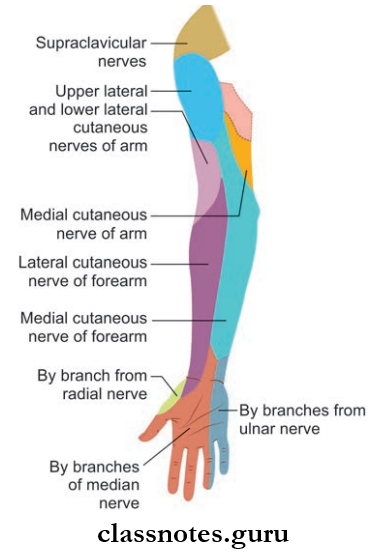
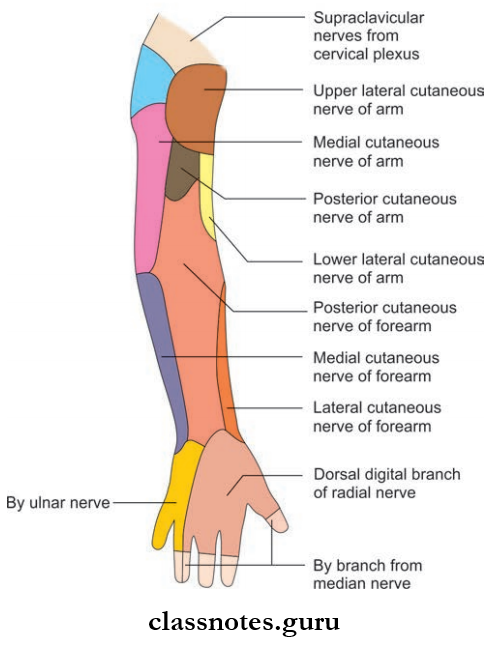
Question 9. Draw the dermatomes of the upper limb.
Answer:
- The area of the skin supplied by one spinal segment is called a dermatome.
- Dermatomes of the upper limb are given in the picture.
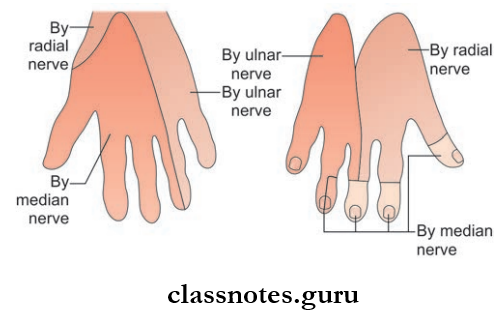

Nerves Of Upper Limb Multiple Choice Questions
Question 1. What is the continuation of the ventral rami of the 7th spinal cord called?
- Medial cord
- Upper trunk
- Middle trunk
- Lateral cord
Answer: 3. Middle trunk
Question 2. A patient presents with loss of abduction and weakness of lateral rotation of the arm. This is due to injury to a nerve caused by a fracture of the humerus at:
- Anatomical neck
- Midshaft
- Surgical neck
- Medial epicondyle
Answer: 3. Surgical neck
Question 3. Which nerve is injured if on trying to make a circle by touching the tip of index finger and thumb, the approximation of palmar spaces of distal phalanx occurs (as in pinching)?
- Median nerve at wrist
- Anterior interosseous nerve
- Recurrent branch of the median nerve
- Deep branch of ulnar nerve
Answer: 2. Anterior interosseous nerve
Question 4. A sportsman with a severe injury to their right leg had to use crutches for several months. Subsequently, his doctor found that he had restricted abduction of shoulder and extension of the elbow. What is the site of injury to the brachial plexus?
- Middle trunk
- Posterior cord
- Lateral cord
- Medial cord
Answer: 2. Lateral cord
Upper Limb Nerve Supply Viva Questions
Question 5. Which dermatome overlies the thumb?
- T1
- C8
- C7
- C6
Answer: 4. C6
Question 6. The skin overlying the thenar eminence is supplied by:
- Recurrent branch of the median nerve
- Palmar cutaneous branch of ulnar nerve
- Palmar cutaneous branch of the median nerve
- Lateral proper digital branch of the median nerve
Answer: 3. Palmar cutaneous branch of the median nerve
